Rainbow Shark | A to Z Guide – Care, Tank Mates, Size and Diet

Table of Contents
Overview/Origin
Rainbow sharks resemble a lot like real sharks when in fact they do not belong to the same family. Also called the Red Fin Sharks or Ruby Sharks, these fishes had dorsal fin forms that are like the apex predators of the ocean. Yet, this aquatic creature is still without a doubt different in size and species than sharks.
One could say that they are more close in size with minnows. Well, for a fact this is true as rainbow sharks belong to the Cyprinidae family where minnows classify as.
The fish breeds most in the warm rivers of Southeast Asia such as Thailand, and Laos. But some say that these fishes have decreased in number because of the damming issues at Xe Bangfai, Laos. Most of the rainbow sharks originated in this place for years and spread to many parts of Asia.
Getting in the league of aquatic trade, these freshwater species are decent for creating a different environment to any fish tank. If you are aiming to own these precious creatures, having some experience in fish care is a very good advantage.
Appearance

The body frames of the rainbow sharks can grow up to 6 inches. With their sizes, you can own them in a few pairs.
Rainbow sharks sometimes have gray or dark bodies, wherein orange-hued fins extend. Their long, slender bodies also make them appear as mini forms of sharks– especially on their distinct dorsal fins rearing on their backs. These dorsal fins have 11 bony spines branching out from their small bodies.
They have flat faces with caved-in eyes paired with a slightly rounded snout. Once they reach sexual maturity, one can observe that they have clear gender differences in their bodies too!
A trait that you can easily compare in both males and females are their colors. The males have much more vivid colors (i.e., red or orange) compared to their counterparts. Females, opposed to males, had no gray lines on their tail fins and are round-bellied.
You would also love the appearance of the rainbow sharks in their albino variety! Fish owners observed that these are the ones that have pinkish-white or yellow-white bodies. Even so, the fins would stay colored orange or blue in these albinos.
Behaviour & Temperament
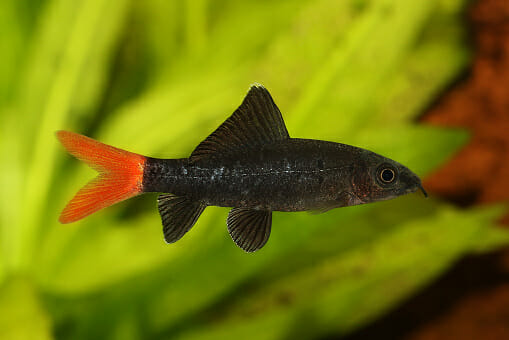
Are Rainbow Sharks Aggressive?
If you are only beginning to manage an aquarium, rainbow sharks should not be your first go-to. These fishes are a little bit difficult to take care of because of their mild to moderate tendency to be aggressive. Their kind has a very territorial nature, and this may come as a threat to other fish species inside the tank. The same behavior can also even manifest to their same kind.
Rainbow sharks, when aggressive, tend to bite, chase and attack those who come near their hiding places. Our advice is to buy a long aquarium tank to ensure that each shark fish can maintain their distance from each other.
The owner must be particular with each fish’s spaces as they tend to be more territorial as they age more. It is also good to prop the tank with hiding areas for these species to be comfortable too. Items may include tunnels, hollowed decors, or tall plants.
The rainbow sharks are also known to stay at the bottom of the tank most of the time. So in case you decide to let some other fishes into the community, consider having those that always dwell at the top part of the waters. This way, no to less interaction will occur between the rainbow sharks and the other tank fishes.
Despite the slightly offensive nature of this fish, the good news is that they are sure to be eye-pleasing in the waters. Aside from them having intense hue colors, they are very active swimmers! With their movement, they are real show stoppers under lighted waters.
Lifespan
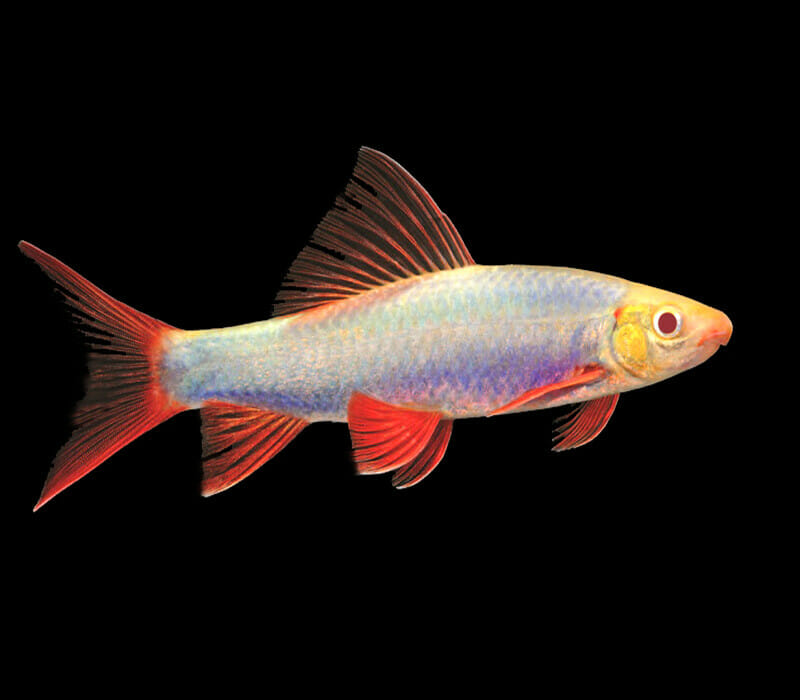
How long does Rainbow Sharks live?
A typical rainbow shark can live for as long as five years. But given enough to live with adequate diet and water conditions, they can even live longer for about eight to ten years! Most small fishes can only live for up to three years; thus, it is safe to say that rainbow sharks are worth your money to invest in!
To maintain the longevity of the aquatic creatures in your tank, you may try to maintain healthy levels of certain substances in the water. For example, to prevent high amounts of chloramine on it, it is best to keep sodium thiosulfate in hand for water stabilization.
Common Diseases
Like other tank fishes out there, rainbow fish’s health can also be threatened if they are living in poor water conditions. Few of the disorders that they may suffer from are the swim bladder disorder and common bacterial and fungal infections.
Unfortunately, no particular medication can be done to treat most of the fish ailments. A primary rule in taking care of rainbow sharks is to consistently provide a well-sustained habitat in their lifespan.
Swim Bladder Disorder
Swim bladder disorder is a common disease that rainbow sharks can contract like any other small freshwater fish. The ailment is most observed with the fish’s trouble to maintain its buoyancy in the waters. A fish owner will know that a fish is suffering from the disorder if it sees it having difficulty in trying to float or sink. Most of the time this happens because of the fish’s distended belly, and other affected organs.
The fish would be struggling with its swimming and sometimes it would prefer leaning on its sides. If your fish is suffering from such a disorder, you must take some more specific measures. A regular assessment of the water state and fish appetite are a few of the fundamental things that should be set by the owner from time to time.
The swim bladder if infected can be tragic for the fish’s longevity. Not only can it shorten the fish’s life, but it can also kill the fish if untreated. As the fish owner, it’s best to deliver a consistent crucial treatment to the tank environment.
Equip yourself with proper fish care knowledge to prevent the uncanny symptoms of the disorder: fish floating or sinking oddly. You need to always pay close attention to a) water replacement, b) water temperature, c) healthy fish appetite and, d) amount of food served.
Bacterial and Fungal infections
Though sturdy as a small fish, rainbow sharks can still be prone to harmful elements present in their biome. As a responsible fish owner, you should be able to keep an eye on the cleanliness of their water from getting contaminated with dangerous substances.
One of the few health culprits is the ammonium spike. Excess food that gets to the bottom of the tank may trigger bacterial build-up and ammonia that may not only kill a single fish but can even wipe an entire fish tank community.
Rainbow sharks do not react well with unreplaced water. Any bacteria colony can still penetrate the organs of these fishes if water maintenance is not practiced well. You can prevent the waters from spoilage by having a serious take on the water guidelines.
Size
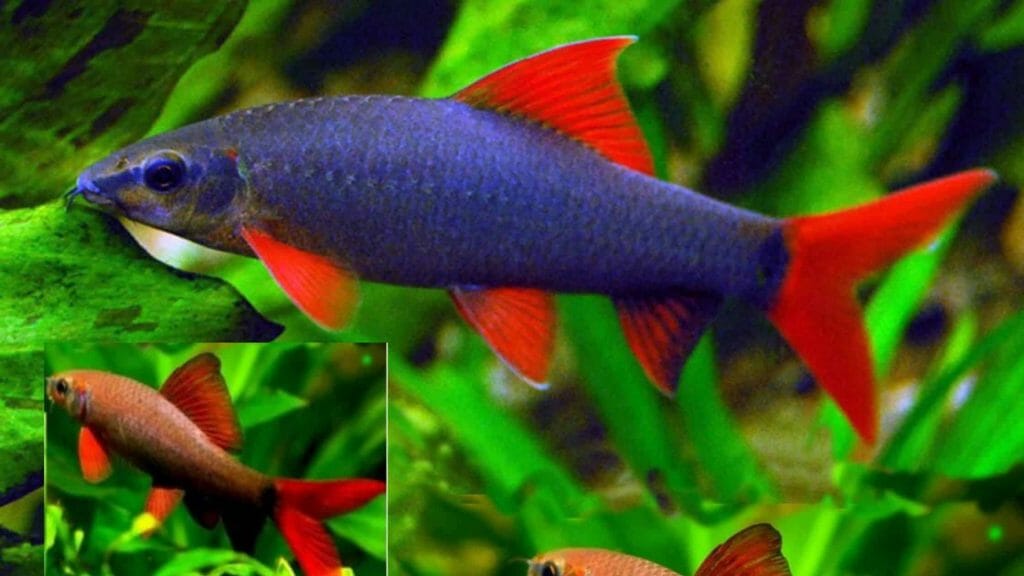
How big do Rainbow Sharks get?
This native fish from Southeast Asia can grow for up to 5-6 inches in length. The size is quite appreciable for a small fish, indeed! By the way, the albinos of their kind also have the same measure.
This size stands true for both the male and female origins and as a fact, it is their average length when they mature. Some fish owners also say that theirs can even reach up to 8 inches! With this long, then a spacious aquarium can be a very satiable container for them.
Once born, these red-finned sharks do not have a clear growth unless they get 1/2- 1 inch big. It would take a while for them to achieve their natural size growth, say a matter of months before getting their distinct body scale. Owning this fish, you may know they have matured once they almost get 4 inches long.
How many Rainbow Sharks can be kept together?
In a regular tank, one to two rainbow sharks should suffice for the owner. Because managing the fish is a little bit tricky, keeping them at a few can also grant you the advantage of taking in other fish species for the tank.Always remember that the fewer of these fish, the better.
If you are to own a lot of red-finned sharks, we tell you to look for a long rectangular size tank for them to have more freedom to roam. With them being aggressive even to their kind, boundaries they set will be a lot easier. If you are attaining to breed the fish, the size of the tank must be able to hold any future offspring too!
Rainbow Shark Care
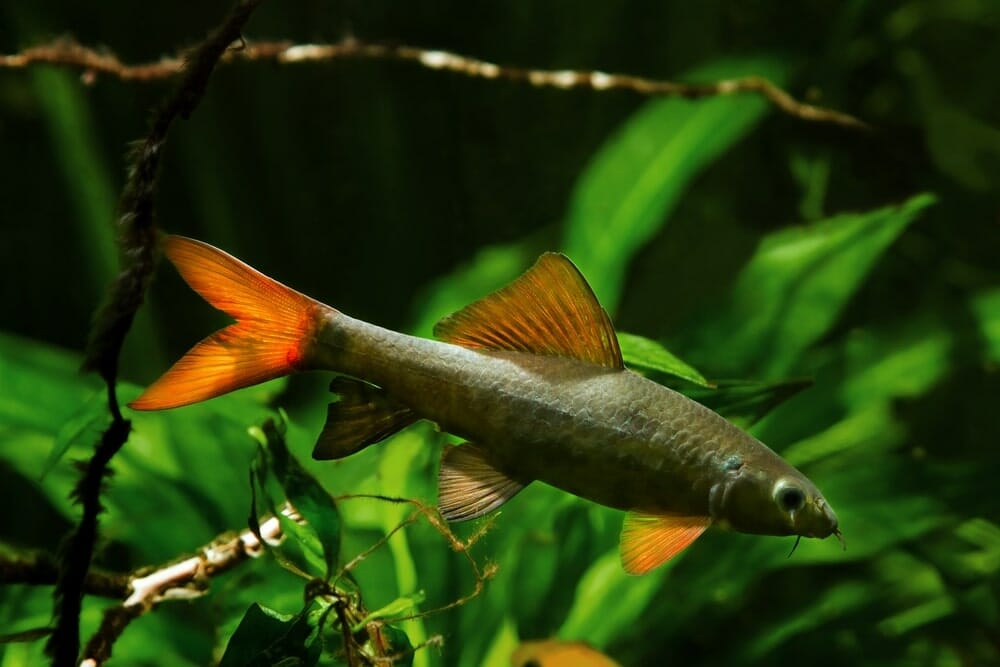
Tank Size
For practical reasons, you must get a large, horizontal tank for your rainbow sharks. This way, they will never feel cramped on their swimming and can be less aggressive too! Take a tank that can provide at least four feet long and 18 inches wide for every fish.
You may also ask what if you decide to take in other fish species as its tank mates. Well, as most experienced fish owners say, you can, for a fact, include any fish in the tank as long as there are low to no chances of territorial attack that may occur.
As a new owner, you can avoid this show of aggression by getting a larger tank that can suffice for all the needed fish space. The minimum tank size for managing rainbow sharks is 50 gallons.
Tank Setup
Our tropical freshwater fish enjoys a habitat that has lots of plants and caves. Making their biome is almost the same as all the other small aquarium fishes out there! The closer you make their tank to the confines of their natural home, the better for them to be more comfortable with the new one.
The tank should handle more than 50 gallons of water and has an excellent horizontal space. If you want to own many red-finned sharks, a 125-gallon tank is a better container.
Fill your aquarium with green, beautiful plants. The plants will not only mimic the appearance of a natural water habitat; it also lessens the risk of trouble between fishes. You may also add rocks and driftwood to add some hiding places for your territorial rainbow sharks!
You can either choose sand or fine gravel for the substrate, as this feels close to their place of origin (Thai rivers). Sand is the most suitable too, as this beautifies the tank ambiance and is even easier to clean!
Pick a tank that has a good lid in it. A fun fact about rainbow sharks is that they may tend to jump from time to time, but the thing is, they are not good at landing! For sure, you don’t want to have your fish land on the floor, do you?
Water conditions
Like most small fishes for the aquarium, the home of the rainbow sharks should have constant maintenance to prevent its spoilage. Water that is properly adjusted to adequate levels is essential for the fish to live a longer lifespan.
- Water temperature. The rainbow sharks thrive longer in waters that are provided with heat up to only 72-79 degrees Fahrenheit. Temperature can be adjusted in between this range and must be consistently provided in the tank.
Doing so also helps in the prevention of certain illnesses that the fish may get from temperature changes. For your convenience, using a tank heater can help sustain the adequate water temperature without your close supervision.
- pH levels. Make sure a water pH level ranging from 6.5 to 7.5 (slightly acidic) is supplied for the rainbow sharks. This can be done immediately before transferring the newly bought fish into the tank. As a rule of thumb, a two-week cycle of stabilizing the tank water prepares the new environment for the fish.
If you are only beginning to take care of these so-called ruby sharks, a routine replacement of 20% to 25% to the tank water supply must never be bypassed. It is the owner’s responsibility to have the water cleaned for him to enjoy his rainbow sharks for a long time.
Diet & Feeding
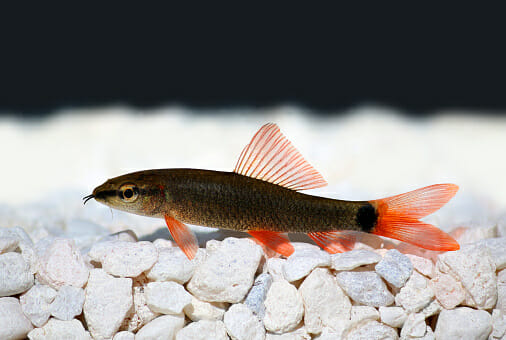
What do Rainbow Sharks eat?
With rainbow sharks being omnivores, you can serve them almost anything on the fish food list! The places that ruby sharks have come from are rich in algae and larvae, and so there is little to no trouble hunting for food.
For your fish to have good health and live longer, the following essential foods should always be in stock:
- Flake food
- Bits of meat
- Insect larvae
- Frozen bloodworms
- Tubifex worms
- Brined fish
- Freeze-dried crustaceans
Never forget to also include veggies as part of their daily nutrition! Consider having some pieces of boiled spinach, bits of cucumber, and peas in reserve for a variety on their diet. Giving plant and animal foods must be in mixed proportions.
Some more tips in feeding the ruby sharks are as follows:
- Proceed to give more soft vegetables to the young fishes. Doing so prevents them from getting stunted growth and have more vibrant colors.
- If you have skipped giving a meal or two, never try to overfeed the fish, as this results in excess food getting in the bottom of the tank that may contribute to harmful ammonium spikes.
- If leaving your fish unattended for days or weeks, it is best to have someone to tend after them and not only rely on any automatic feeder mechanism.
How often should I feed my Rainbow Sharks?
An excellent food regime for ruby sharks comes on how many times you feed your fish, too. Aim at least to serve plant and meat portions two to three times a day.
Also, observe a maximum of 5 minutes for every feeding session for your rainbow sharks.
Certain foods get more attention from the fish if it is sinkable. Observe that the food you give is limited so as to not spoil the water from uneaten food. Always try to avoid decaying food by cleaning the bottom of the tank and replacing the water on time.
How long can Rainbow Sharks go without food?
If you cannot keep up with the regular feeding schedule of your fish, rainbow sharks can survive for at least three to five days of no food. Furthermore, the days can extend longer if the owner has served the fish a consistent diet beforehand. In this way, you can assume that a well-fed fish can thrive well while you are away!
If you are away for more than a week and have nobody to tend for your tank, try to use edible plants for rainbow sharks. You can place plenty of edible plants inside the tank as a supplementary substitute for their food. Only take the automatic feeder for your last resort.
Tank Mates
What fish can live with Rainbow Sharks?
The rainbow sharks are known for being bottom dwellers, they would even love to feed on algae existing on the tank bed. In places where these fishes come from, they are also observed to frequent in caved areas, and tunnel-like structures.
This said, if you are looking forward to joining other fish species in the tank, it is advisable to not choose the ones who also settle on the bottom. Remember that the red-finned sharks are not so friendly even of their kind!
Be guided with the following top suitable fishes you should choose for the rainbow shark:
- Loaches
- Rasboras
- Gouramis
- Rainbowfish
- Zebra Danios
What fish don’t do well with Rainbow Sharks?
As the fish settle most on the bottom area of the tank, it is not convenient to pick bottom-dwelling fishes too. Making a stress-free community in the environment requires you to drop the ones that may trigger the aggressiveness of your fish.
Some of the fishes you should avoid for your rainbow sharks are those that are long-finned, too. With rainbow sharks being semi-aggressive, they may try to chase on other fishes that have long or large fins. Try to also avoid other fishes that are fin nippers. The fin nippers are most likely having aggressive behaviors too.
Schooling fishes are primarily a no-no for the tank, especially if they are active swimmers and can be seen in all parts of the aquarium. If you only have a small tank, it is best not to include the following fishes with the rainbow sharks:
- Cichlids
- Catfish
- Bala sharks
- Red-tail sharks
Breeding
In their natural settings, the rainbow sharks breed between the months of October and November. You can say that they still depend on seasonal change for producing offspring.
If you would like to invest time in breeding them, you only have to know which ones have matured already. You may notice a rainbow shark as capable of mating if it reaches a length of more than 4 inches. Female adult fishes may lay their eggs on gravel more at the bottom of the tank. Males, on the other hand, will produce milt to these eggs as a way of fertilization.
Though as it may sound easy to conjure, breeding these ruby sharks are challenging to do. As these are semi-aggressive fishes that we are talking about, breeding them in captivity proves difficult even to experienced fish owners. Still, there are successful breeders that you may learn from and they are those that have established fish farms in Southeast Asia.
Summary
Despite the aggressive nature of rainbow sharks with other fishes, they are still great to have in any themed aquarium. With an excellent tank setup and compatible tank mates, your tank can still be fascinating with these fishes as you always want it to be.
You will not have much of a hassle feeding them, as they can eat whatever fish food you give! As an owner, you only have to be wary of them being at the same tank with other fishes because of their territorial behavior.
Keeping them can be very tricky for beginners, so it is best to keep only one or two of them in the tank. If you are interested in having them in your tank, experience in fish keeping will be very handy for you!